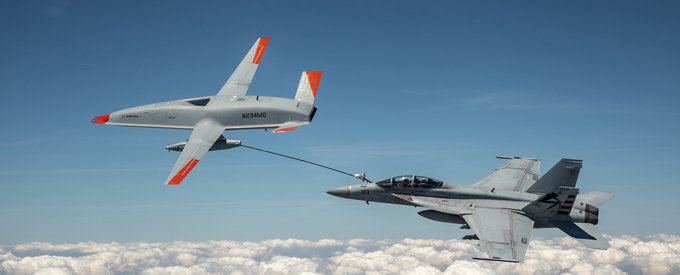2021-07-05
MQ-25 Breaks New Ground
Recently, the MQ-25 programme successfully conducted the first ever aerial refuelling operations between a manned receiver aircraft and unmanned tanker from MidAmerica Airport in Mascoutah, Illinois, U.S.
During a test flight on June 4, MQ-25 T1 successfully extended the hose and drogue from its U.S. Navy-issued aerial refuelling store (ARS) and safely transferred jet fuel to a U.S. Navy F/A-18 Super Hornet. This successful flight demonstrated that the MQ-25 Stingray can fulfil its tanker mission using the Navy’s standard probe-and-drogue aerial refuelling method.
“This flight lays the foundation for integration into the carrier environment, allowing for greater capability toward manned-unmanned teaming concepts,” said Rear Adm. Brian Corey who oversees the Programme Executive Office for Unmanned Aviation and Strike Weapons. “This team of professionals was integral in the successful flight. MQ-25 will greatly increase the range and endurance of the future carrier air wing – equipping our aircraft carriers with additional assets well into the future. Over the next few years, we will work side-by-side with Boeing to deliver this capability that will greatly enhance the future carrier air wing.”
“This is our mission, an unmanned aircraft that frees our strike fighters from the tanker role, and provides the Carrier Air Wing with greater range, flexibility and capability,” said Capt. Chad Reed, programme manager for the Navy’s Unmanned Carrier Aviation programme office (PMA-268). “Seeing the MQ-25 fulfilling its primary tasking today, fuelling an F/A-18, is a significant and exciting moment for the Navy and shows concrete progress toward realising MQ-25’s capabilities for the fleet.”
Robust Capability
During the initial part of the flight, the F/A-18 test pilot flew in close formation behind MQ-25 to ensure performance and stability prior to refuelling – a manoeuvre that required as little as 20 feet of separation between the MQ-25 T1 air vehicle and the F/A-18 refuelling probe. Both aircraft were flying at operationally relevant speeds and altitudes.
“This event is a credit to our joint Boeing and Navy team that is all-in on delivering MQ-25’s critical aerial refuelling capability to the fleet as soon as possible,” said Leanne Caret, president and CEO of Boeing Defense, Space & Security. “Their work is the driving force behind the safe and secure integration of unmanned systems.”
The Navy F/A-18 Super Hornet conducted a formation evaluation, wake survey, and drogue tracking. With the evaluation safely completed, the MQ-25 drogue was extended, and the F/A-18 pilot moved in to “plug” with the unmanned aircraft and receive the scheduled fuel offload.
The test flight will provide important early data on airwake interactions, as well as guidance and control, Reed said. The team will analyse that data to determine if any adjustments are needed and make software updates early, with no impact to the programme’s test schedule.
The milestone comes after 25 T1 flights, testing both aircraft and ARS aerodynamics across the flight envelope, as well as extensive simulations of aerial refuelling using MQ-25 digital models. MQ-25 T1 will continue flight testing prior to being shipped to Norfolk, Virginia, for deck handling trials aboard a U.S. Navy carrier later this year.
The Boeing-owned T1 test asset is a predecessor to the seven-test aircraft Boeing is manufacturing under a 2018 contract award. The MQ-25 will assume the tanking role currently performed by F/A-18s, allowing for better use of the combat strike fighters and helping extend the range of the carrier air wing. MQ-25 is a trademark of the Department of the U.S. Navy.
An unmanned aircraft system designed for the U.S. Navy mission, MQ-25 will provide the needed robust refuelling capability, thereby extending the combat range of deployed Boeing F/A-18 Super Hornet, Boeing EA-18G Growler, and Lockheed Martin F-35C fighters.


No Comments